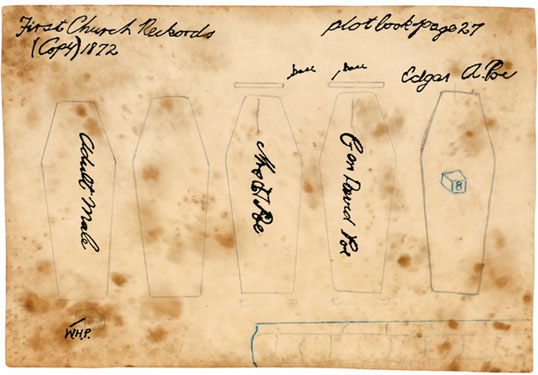∞∞∞∞∞∞∞

This facsimile is based on the drawing, of uncertain origin, in the collection of the Maryland Historical Society.
In 1978, the Maryland Historial Magazine published an article by Charles Scarlett, Jr., a prominent local businessman and Poe enthusiast. The article was titled “A Tale of Ratiocination: The Death and Burial of Edgar Allan Poe” (vol. 73, no. 4, December 1978, pp. 360-374). As part of the surprisingly poorly documented and rather rambling narrative, Mr. Scarlett makes the somewhat sensational claim that the wrong body was exhumed in 1875, and that Poe, therefore, was not moved to the monument that bears his name and instead remains in the family lot. As part of his evidence, he cites a copy of what purports to be from the original plat book. Describing the plat drawing, Mr. Scarlett states:
“Of real significance is the existence among the Marine Papers at the Maryland Historical Society of a plat of David Poe’s lot, number 27, copied or traced in 1872 from the “First Church Records, Plat Book page 27” which book is said to have been lost in the early 1870s. This document was found lodged between the leaves of a 1902 publication relating to the Whig-Republican Party campaign of 1902.
William Matthew Marine (1843-1904) was a Baltimore attorney, Historian and Executive Committee member for the Society of the War of 1812, and for a number of years held the important post of the Collector for the Port of Baltimore. Mr. Marine was also an amateur poet, and quite interested in Edgar Allan Poe. He was among the many people who attended the unveiling of the Poe monument in 1875. He wrote an account of the Glendy Church and Graveyard for the Baltimore Presbyterian in 1884, so the idea that he might have had special access to records for the Baltimore Presbytery is certainly possible. Whose handwriting is shown in the diagram is unknown. The line around the edge of the vault in the bottom right corner, and the small box with the number 8 on Poe’s grave appear to have been written in blue ballpoint pen, and are almost certainly later than the drawing itself. These markings may have been added by Mr. Scarlett. The orientation of the drawing, based on the handwriting, is upside down and backwards from what one would expect if examining the site from the cemetery itself, chiefly due to the presence of the large vault that stands behind the one corner of the Poe lot. The marble slab for Rev. Patrick Allison would be to the right of Poe’s grave as documented in the diagram, or to Poe’s left if one were standing in front of the graves. The “Adult Male” noted at the left side of the drawing, with the initials “W. H. P” represents William Henry Leonard Poe, Edgar’s older brother, who died in 1831. The small box on Edgar’s grave, featuring the number “8” is a reference to the sandstone marker that was left by George W. Spence, the sexton of the church, to show visitors where Poe was buried. Although a few accounts state that the marker carried the number “8,” the more accepted accounts state that the number is “80.”
A more thoughtful discussion about Poe’s burial and reburial was written by Christopher Scharpf as “Where Lies a Noble Spirit? — An Investigation into the Curious Mystery of Edgar Allan Poe’s Grave in Baltimore,” Masques, Mysteries and Mastodons: A Poe Miscellany (Baltimore: The Poe Society, 2006), pp. 194-222. Scharpf chiefly refutes Scarlett’s argument that the wrong body was exhumed in 1875, and blames Dr. Moran for the confusion.
The facsimile shown was copied from the original item in the collection of the Maryland Historical Society. It was created for an exhibit by the Poe Society in the early 1980s. The age toning and foxing in the facsimile roughly imitate the condition of the original drawing.
∞∞∞∞∞∞∞
[S:1 - JAS] - Edgar Allan Poe Society of Baltimore - Baltimore - Poe's Memorial Grave - Poe’s Original Burial Place